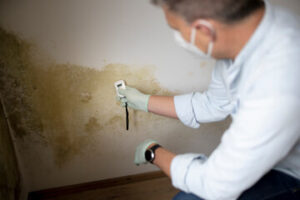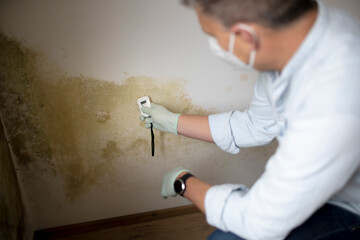Musty odors, suspected mold growth, or the presence of black stains on wood are all reasons to conduct a mold inspection. Depending on the findings, the inspector will recommend remediation and/or prevention.
A mold inspector should first moisture-map the entire property. Moisture is essential for mold growth, and the inspector should identify areas of elevated moisture. If you don’t have time to wait, contact Axios Home Inspection for an estimate!
 Detection
Detection
Mold inspections are typically performed by inspectors who specialize in environmental assessments and often have certifications and experience with mold assessment and remediation. They may use a variety of tools, including moisture meters, cameras specialized swabs, and testing methods.
The first step in a mold inspection is to perform a visual walk-through of the house and look for visible signs of mold growth. The inspector will also note any dampness or odors that might be present. The inspector should look especially hard at places that are more prone to mold growth, such as bathrooms, kitchens, and crawl spaces.
A professional inspector will also conduct a moisture mapping survey of the property. This involves checking areas around doors, windows, plumbing fixtures, and HVAC air handlers to determine if there is a high level of moisture in the building materials. If the inspection reveals a high level of moisture in these areas, the inspector will likely recommend sampling.
There are two standard types of mold sampling: non-viable and viable. Non-viable sampling simply identifies the presence of mold spores, while viable sampling cultures the sample to identify live and dead spores, as well as the specific species of mold present. The type of sample chosen by the inspector will depend on the specific situation and the time frame.
It’s important to note that not all fungi are harmful, and some spores may even be beneficial to the home. This is why a professional must interpret the results of a mold test and recommend any remediation steps, if necessary.
If a person believes they have a fungus problem, they can purchase a home testing kit. These kits usually include Petrie dishes that people place in their homes where they suspect mold to collect spores over 24 hours. The results are then evaluated by the manufacturer and can be compared to the results of a professional testing company.
Before the appointment, the homeowner should close all windows and doors and avoid vacuuming or heavy cleaning. This allows the maximum number of spores to accumulate and makes it easier for the inspector to detect them. It’s also a good idea to turn off the HVAC system two hours before the inspection. This will help prevent the HVAC system from circulating the spores throughout the home, diluting them and making them more difficult to detect.
Sampling
Mold testing is an important tool for determining if a property has a significant problem. However, it should never be used as a replacement for a thorough visual inspection.
During the sampling process, an inspector will use a variety of methods to collect spores for analysis. Depending on the type of testing, the results can take several days to a few weeks. Some of the standard types of tests include ERMI (Environmental Relative Moldiness Index) and DNA testing.
Both ERMI and DNA testing can determine the presence of mold, but they don’t necessarily identify the species of mold or provide information on how much is present in the air. Ideally, the best way to test for a specific mold is through surface sampling. This can be done with a bulk, tape lift, or swab sample. Using a swab sample allows for the identification of both live and dead spores, but can be difficult to get a representative sample in contaminated areas.
Surface samples can be taken from several surfaces, including walls, floors, and furniture. They can also be used to identify the type of mold growth and how widespread it is. These samples can be invasive, however, so an inspector should always exercise extreme care and caution.
Mold can be found in all occupied indoor spaces, and even when it is not visible, it can often be detected by smell or by the presence of mold spores in the air. Mold spores are ubiquitous, and many of them pose no health risk. However, some of them can produce one or more substances called mycotoxins, which are toxic to living tissue. These mycotoxins can cause a range of health effects from mild to severe, and in some cases can be life-threatening.
While it is possible to purchase home DIY kits for conducting mold testing, professional testers use more precise techniques and labs than those available in a typical residential setting. They can also offer detailed reports of the findings. In addition to identifying the presence of mold, a professional mold inspector can recommend procedures for remediation and prevention.
Analysis
A mold inspection should include a careful, visual examination of all accessible areas of the house. It should also look for sources of moisture. Mold growth is associated with moisture, and unless the source of moisture is found and eliminated, the mold will continue to grow.
A good home inspector can use his or her training and experience to identify likely sources of moisture. These can include wet drywall, water leaks, ceiling damage, and condensation on windows and walls. If a potential source of moisture is identified, the inspector should recommend appropriate testing and/or remediation.
During the inspection, the inspector should wear personal protective equipment (PPE) such as goggles, a respirator, gloves, and a Tyvek suit. Samples of air, spores, and surfaces may be collected for laboratory analysis. If surface sampling is conducted, a sample size of at least 30 square feet should be taken. Samples can be collected using several methods, including bulk sampling, which involves collecting bulk materials such as drywall or insulation and analyzing them for the presence of mold. Bulk sampling is often more effective than surface sampling, but it can be expensive and invasive.
While a mold test can indicate whether or not there is a significant problem, it cannot tell the inspector how severe the problem is. The type of mold present, how many spores are present and an individual’s health status combine to determine the extent to which a mold problem poses a health risk.
Some people interpret equivocal or negative test results as proof that no mold problem exists. While it is a serious mistake to ignore a possible problem, it is equally dangerous to assume that a problem does not exist because tests fail to detect it. A professional mold inspector is trained to find places where mold is hidden, such as behind walls, in crawl spaces, or inside HVAC grates. This is important because a mold infestation can spread quickly. It is not uncommon for a small amount of mold to turn into a full-scale infestation in just 48 hours. Mold spores are constantly being released into the air and settling on damp surfaces, making them easy to spread.
Remediation
Once mold growth is detected, a remediation plan needs to be developed. The most important step is to determine the source of the moisture. A home inspector can use a moisture meter to find the source of the problem, or they may need to damage drywall or paneling to get a closer look. Once the source of the moisture is identified, it can be repaired and steps can be taken to prevent future mold growth.
Remediation can be done on a DIY basis if the mold is easily visible, but more extensive problems will need to be addressed by a professional mold inspection and remediation company. A good home inspection company will also have the equipment needed to clean up and prevent future mold growth, including industrial fans to help air out rooms that have been contaminated with mold spores.
Mold accumulation can lead to health issues for those who live in the home and decrease the value of the property. If a home is on the market, having a mold test performed can help reassure potential buyers that the property is free from a serious problem that can be expensive to remedy.
A professional mold inspector will know how to test for a variety of different types of mold and will have the equipment needed to take samples in hard-to-reach places, such as behind walls and inside HVAC ductwork. They will also know how to safely and effectively use a variety of tools, including a hygrometer, a thermal imaging camera, and a moisture meter.
A professional mold inspector will follow industry best practices when testing for mold in a home. If you suspect that you have a mold problem in your home, or are concerned about buying a house with potential mold problems, contact an experienced inspector to schedule a test and inspection today. A full-service residential and commercial mold inspection and mold testing company that uses the most advanced technology in the industry to provide clients with safe, healthy living environments. Call us today to schedule a mold inspection for your home or office!

